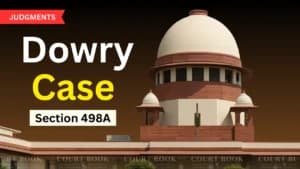In a significant decision aimed at addressing the rising backlog of cases in High Courts, the Supreme Court of India has relaxed the conditions for appointing ad hoc judges under Article 224A of the Constitution. This move is expected to help clear the mounting pendency of criminal and civil cases across various High Courts.
Background: The Need for Ad Hoc Judges
The Supreme Court had earlier set stringent conditions for the appointment of ad hoc judges in its April 2021 ruling in the Lok Prahari v. Union of India case. According to the previous directive, ad hoc judges could only be appointed if vacancies exceeded 20% of the sanctioned strength in High Courts. However, given the growing backlog of cases, the court has now suspended this requirement.
Read Also:-Madhya Pradesh High Court Fines State Government for Alleged Violation of Land Acquisition Act
Current Backlog in High Courts
- Over 62 lakh cases are currently pending in High Courts.
- Out of these, 18 lakh are criminal cases, and 44 lakh are civil cases.
- The National Judicial Data Grid has highlighted that the pendency levels have been rising across most High Courts.
Considering this situation, the Supreme Court has modified the earlier conditions to allow for a more flexible and practical approach to judicial appointments.
1. Removal of the 20% Vacancy Requirement
The Supreme Court has kept in abeyance the previous rule that ad hoc judges could be appointed only if more than 20% of the sanctioned judicial strength remained vacant. This means High Courts can now recommend ad hoc judges regardless of the percentage of vacancies.
2. Number of Ad Hoc Judges Allowed
Each High Court can now recommend 2 to 5 ad hoc judges, ensuring that the total does not exceed 10% of the sanctioned strength.
3. Role and Responsibilities of Ad Hoc Judges
- The ad hoc judges will primarily sit as junior judges in two-judge division benches.
- Their primary role will be to hear pending criminal appeals and help clear case backlogs.
- They will work alongside sitting judges, ensuring smooth judicial proceedings.
4. Ad Hoc Judges to Be Selected from Retired High Court Judges
As per Article 224A of the Constitution, retired High Court judges can be appointed as ad hoc judges. The Supreme Court clarified that the existing Memorandum of Procedure (MoP) will continue to guide their appointments.
Read Also:- EPF Pension: Kerala HC Directs EPFO to Maintain Higher Pension for Petitioners
The Attorney General for India, R. Venkataramani, expressed the government's complete agreement with the court's decision. He stated that procedural aspects could be sorted out later, allowing High Courts to move forward with these appointments without delay.
Past Supreme Court Rulings on Ad Hoc Judges
- April 2021 Judgment (Lok Prahari Case): The Supreme Court had approved the appointment of ad hoc judges but with strict conditions.
- Warning Against Over-Reliance on Ad Hoc Judges: The court had previously emphasized that ad hoc appointments should not become a routine alternative to regular judge appointments.
- Trigger Points for Ad Hoc Appointments (Now Suspended):
- Vacancies exceeding 20% of sanctioned strength.
- Cases pending for five or more years.
- More than 10% of backlog pending for over five years.
- Rate of new case filings exceeding the disposal rate.
Given the alarming increase in pending cases, the court has now relaxed these restrictions, enabling faster judicial proceedings.
Read Also:- Calcutta High Court Forms SIT to Investigate Sandeshkhali Gang Rape Case, Addresses Delays in Probe
The Supreme Court’s decision to ease conditions for appointing ad hoc judges is a significant step toward tackling the judicial backlog in High Courts. By allowing High Courts to appoint 2-5 retired judges without waiting for vacancies to cross the 20% mark, this ruling ensures that pending cases, particularly criminal appeals, are addressed more efficiently. The move is expected to speed up the justice delivery system while maintaining judicial efficiency.













